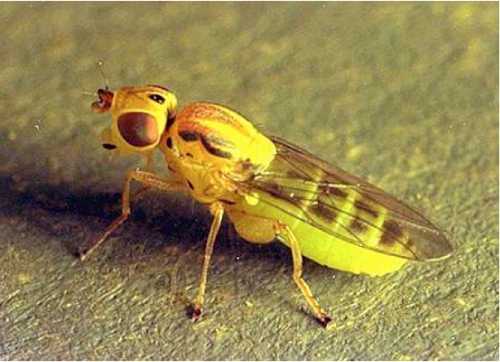Symptoms, description and lifecycle
Wheat plants affected by Wheat stem maggot show stunting, distortion and decreased tillering. The most obvious symptom is the presence of the “white hand” condition typically produced by stem-boring insects. In this condition the seed head dies and turns white while the lower stem regions and leaves remain green. Infested stems will pull out very easily, and contain a single maggot just above the last node.
When young tillers are attacked in the autumn or early spring, the tillers usually die; infested plants show the “white head” condition typically produced by stem-boring insects. The adult flies are about six millimetres in length, and pale green to yellow with dark stripes.
The adult fly is four to five millimetres long, with clear wings. They have a mostly yellow body (forms can vary) with three dorsal black stripes, swollen hind femurs, the head protruding forward between the eyes, and the corner of the mouth forming a nearly right angle. Larvae of Wheat stem maggot enter the stem of wheat or other grass species and feed on the soft inner structures, usually in close proximity to the top node.
Organism
Meromyza americana
Host range
Preferentially attack wheat, but will also attack barley, rye, oats, bluegrass and millet.
Conditions favouring pest
Wheat stem maggot can cause significant damage in spring sown wheat, while limited damage is likely to occur to autumn sown wheat. Spring sown wheat is of further risk after high rainfall in summer.
Method of spread
Movement of Wheat stem maggot typically occurs in plant material.
Where?
Meromyza americana is found in North America from Mexico to Canada.

Image 36. Adult Wheat stem maggot.
Source: Kansas State University.


